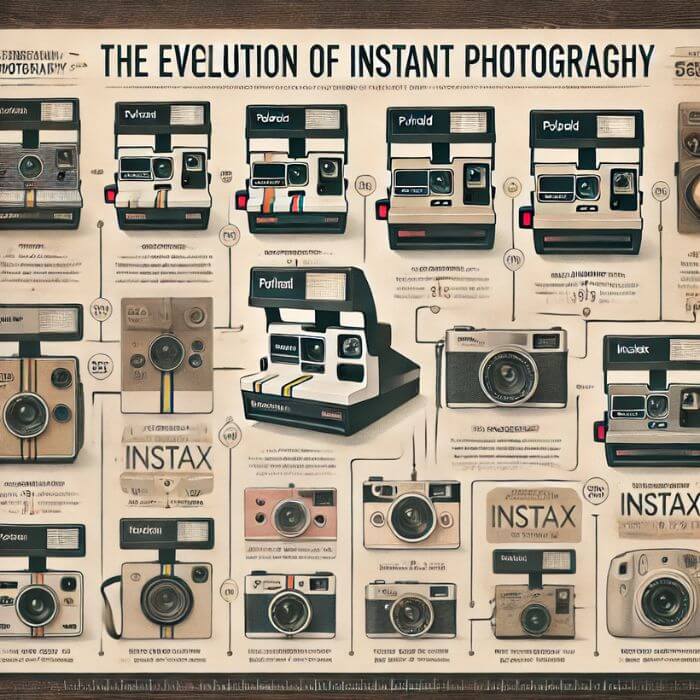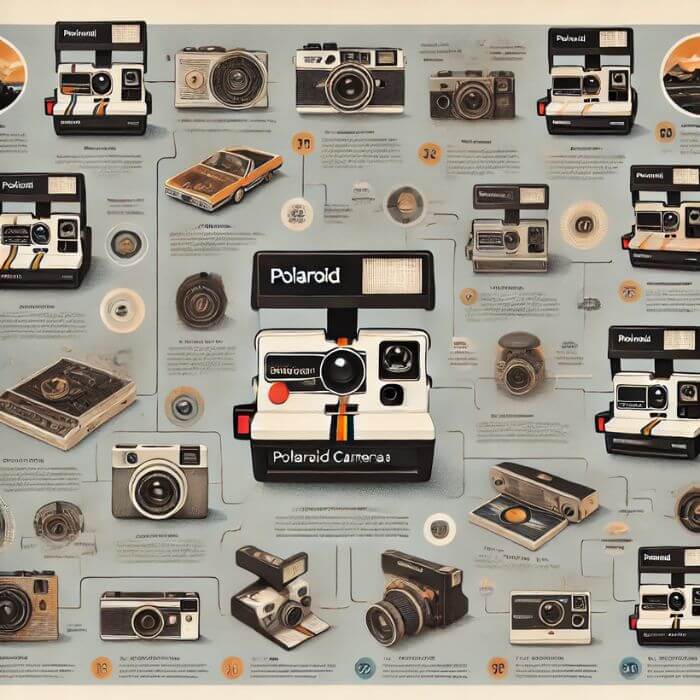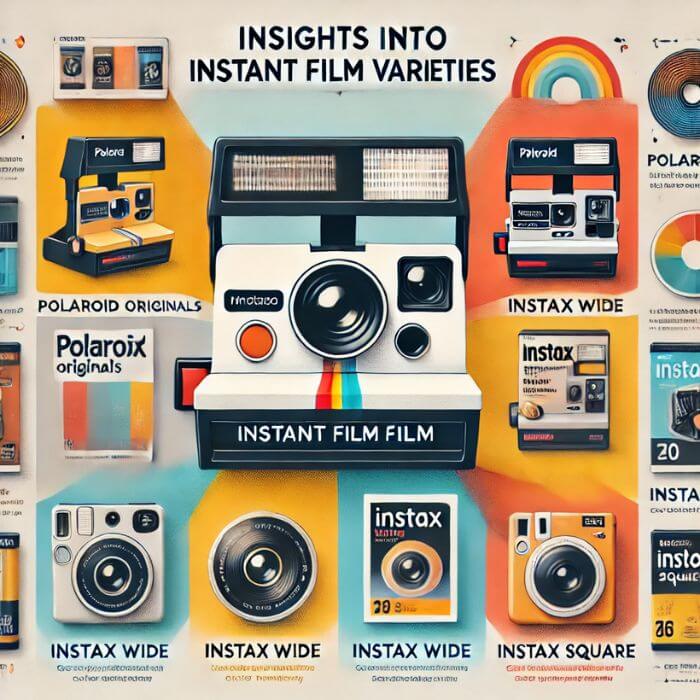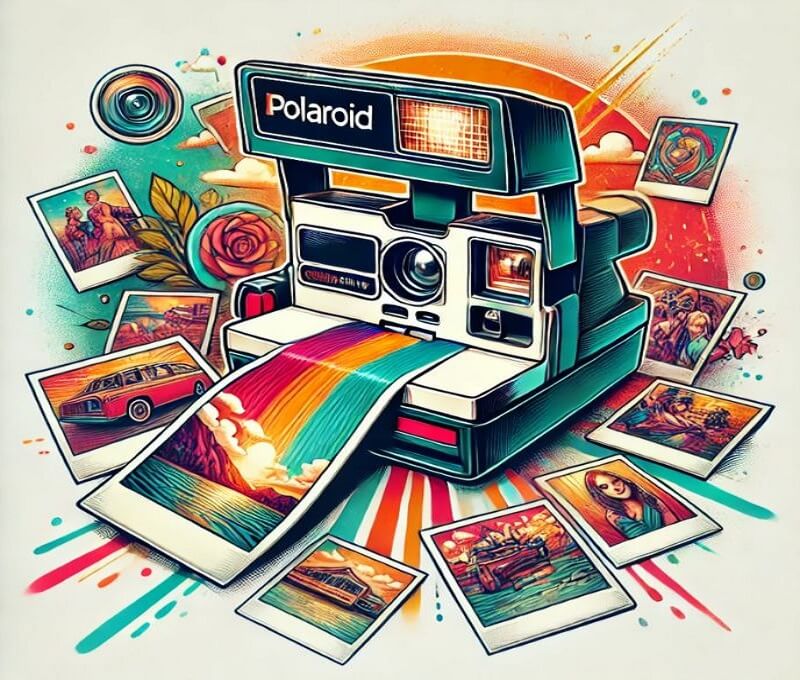Did you know that sales of instant film cameras, like the Polaroid camera and Fujifilm Instax Mini, have surged by 30% in recent years? The resurgence of interest in these iconic devices, instax cameras and digital cameras, has sparked curiosity about what makes them so special. A polaroid camera isn’t just a gadget; it’s a time machine that captures moments and delivers tangible memories instantly.
Polaroids, instant photos, and instant cameras are more than just snapshots – they’re physical keepsakes that evoke nostalgia and create an authentic connection to our experiences.
The Evolution of Instant Photography

Edwin Land’s Invention
In 1948, Edwin Land, a photographer, invented the first instant camera, which revolutionized photography by capturing instant photos. Unlike traditional cameras that required film development, instant cameras produced photographs immediately after being taken. This innovation marked a significant shift in the way people captured and shared instant cameras, photos, and memories.
Land’s invention of instant cameras allowed individuals to take a photo and have it develop within minutes using instant film, eliminating the need for professional processing. This convenience made instant photography immensely popular among amateurs and professionals alike.
Convenience and Popularity
The appeal of instant photography lay in its convenience, immediate results, and format. With traditional film cameras, photographers had to wait days or even weeks to see their developed images. However, with instant cameras, people could pick a format, capture moments, and hold physical prints in their hands within minutes.
This immediacy changed how individuals documented events such as birthdays, holidays, and everyday occurrences with instant cameras and instant film. Family gatherings became opportunities to pick series of tangible memories instantly rather than waiting for film development.
Instant photography also gained popularity due to its simplicity. Users did not need extensive knowledge of shutter speed, exposure settings, or image quality; they simply aimed the instant camera at their subject and pressed the shutter button.
The previous section talked about “the history of Polaroid cameras.” You can engage with the preceding section within this section by highlighting how Edwin Land’s invention paved the way for Polaroid cameras’ success.
Understanding the Mechanics of Polaroid Cameras
Unique Self-Developing Film Process
Polaroid cameras are fascinating because they don’t just capture a moment, but also bring it to life right before your eyes. When you take a photo with an instant camera, the magic begins. The film in instant cameras contains layers of chemicals that react when exposed to light. Once the shutter clicks, the instant film is ejected from the camera and starts its journey through an intricate process.
The first layer of chemicals in instant cameras film reacts to light and captures the image. Then, as the instant camera moves out of the camera and into daylight, another set of chemical reactions kick in. These reactions create dyes that form the actual photograph on paper within minutes using instant cameras. It’s like having your own personal darkroom inside your instant camera!
This unique self-developing film process sets polaroid cameras apart from traditional ones where you have to wait for days or hours to see your pictures.
Chemical Reactions and Physical Processes
The mechanics behind polaroid cameras involve both chemical reactions and physical processes working together seamlessly. As soon as you press down on that iconic red button, several things happen at once inside the instant camera.
The exposure meter measures how much light is available in instant cameras, allowing just enough light to pass through onto the film without overexposing it. Simultaneously, instant cameras’ tiny gears start rolling inside as they pull out one piece of film while positioning another for use.
Once outside, instant camera rollers spread a reagent across this developing picture which triggers those magical chemical reactions mentioned earlier – turning latent images into vibrant memories! All these steps occur quickly yet precisely within seconds so you can watch your memory materialize almost instantly.
Key Features of Polaroid Cameras
Simple Operation
Polaroid cameras are known for their simple operation. You just point, shoot with an instant camera, and in a few seconds, the photo prints out. There’s no need to worry about complicated settings or editing images on a computer with an instant camera. This makes instant cameras perfect for capturing memories quickly and easily.
Some models even have an autofocus feature, which means the camera automatically adjusts the lens to make sure your photos are clear and sharp. This instant camera takes away the guesswork and ensures that your pictures turn out great every time.
Manual Controls
Many Polaroid cameras offer manual controls for exposure and focus. This means you can adjust settings like brightness and where the camera is focusing to get exactly the kind of picture you want. It gives you more creative freedom compared to basic point-and-shoot cameras.
For example, if you’re taking a close-up shot of a flower, you can manually adjust the focus so that the flower is perfectly clear while the background is beautifully blurred. These manual controls allow photographers to experiment with different styles and techniques.
Additional Versatility
In addition to their simple operation and manual controls, some Polaroid cameras include extra features that add versatility to your photography experience. For instance, many models come with a built-in flash that allows you to take well-lit photos even in low-light conditions.
Moreover, certain Polaroid cameras also have self-timers, allowing users to set up group shots or capture self-portraits without needing someone else behind the lens. By using these additional features, people can explore various types of photography beyond just standard snapshots.
Exploring Different Types of Polaroid Cameras

Vintage Models
Polaroid cameras come in various types, from vintage classics to modern versions. Vintage models such as the SX-70 and Land Camera are highly coveted by collectors for their historical significance and unique features. The SX-70, known for its foldable design, was a groundbreaking invention when it was first introduced. On the other hand, the Land Camera series gained popularity due to its iconic bellows design and manual controls.
These vintage models offer a nostalgic experience with their classic design and original film formats. However, they may lack some of the advanced features found in modern Polaroid cameras.
Modern Versions
In contrast to vintage models, modern Polaroid cameras like the OneStep+ and Instax Wide series have been designed with updated features to cater to contemporary preferences. The Instax Wide series is known for producing larger instant prints compared to traditional square formats. These modern cameras also offer enhanced compatibility with new films that provide improved image quality and color accuracy.
The OneStep+ camera stands out for its Bluetooth connectivity feature which allows users to control settings remotely using a smartphone app. This integration of technology makes it convenient for users who want more control over their photography experience.
While vintage models exude charm with their retro appeal, modern versions prioritize convenience and innovation without compromising on image quality.
Digital vs. Analog Polaroid Cameras
Digital Cameras
Digital cameras are modern devices that capture and print photos digitally, eliminating the need for film. These cameras use batteries to power up and have a digital screen to view the images before printing. With digital polaroid cameras, you can take multiple shots of the same scene without worrying about wasting film.
They offer convenience as there’s no waiting time for the prints to develop since they are produced instantly on special paper. However, some people argue that digital polaroid cameras lack the charm and nostalgia associated with analog ones because they don’t produce physical prints immediately.
Analog Cameras
Analog cameras, also known as instant cameras or polaroid cameras, use specialized film to produce physical prints instantly after capturing an image. Unlike their digital counterparts, these cameras do not require any batteries but instead rely on mechanical processes for capturing and printing photographs.
The appeal of analog polaroid cameras lies in their ability to create tangible memories right before your eyes. The unique aesthetic quality of instant film photography adds an element of surprise and authenticity to each print. Many enthusiasts appreciate the tactile experience of shaking a freshly taken photo while waiting for it to develop.
Insights into Instant Film Varieties

Range of Films
Polaroid Originals offers a variety of instant film options suitable for different camera models. These films are designed to produce instant prints, allowing users to have physical copies of their photos immediately after taking them. The range includes films compatible with the classic Polaroid 600 series as well as the newer i-Type cameras.
The films available from Polaroid Originals include color, black and white, and special editions with unique frames. For instance, the color film produces vibrant and lively images, while the black and white option captures classic monochrome photographs. Special edition films come with distinct borders or patterns that add a creative touch to the printed pictures.
Characteristics of Film Types
Each type of film possesses specific characteristics that contribute to its unique visual appeal. Factors such as contrast, saturation, and grain vary among the different film varieties offered by Polaroid Originals. For example:
Color films may exhibit rich saturation and vivid hues.
Black and white films often emphasize contrast and fine details.
Special edition films showcase distinctive frame designs that complement various photography styles or themes.
In addition to Polaroid Originals’ offerings, other popular instant film brands like Fujifilm Instax also provide a wide range of options for enthusiasts who enjoy using instant cameras.
Creative Techniques with Polaroid Cameras
Double Exposures
Creating double exposures with a Polaroid camera is like blending two pictures into one. You take a photo, then without advancing the film, you take another picture on the same frame. This technique allows you to overlay two images for unique and artistic effects. For example, capturing a portrait over a landscape can produce an intriguing and surreal composition.
Experimenting with double exposures can result in unexpected and captivating images that tell stories within a single print. It’s like combining different puzzle pieces to create an entirely new picture that sparks imagination and creativity.
Manipulating the Development Process
When using a Polaroid camera, manipulating the development process can lead to dreamy or vintage-looking photos. By shielding the photo from light as it develops or controlling temperature and humidity conditions, you can influence the final appearance of your prints.
For instance, if you cover the photo immediately after it ejects from the camera using your hand or any opaque object, parts of it may remain underdeveloped while others become more pronounced. This manipulation creates an ethereal aesthetic that adds depth and character to your photographs.
Experimenting with Lighting, Angles, and Composition
Exploring various lighting conditions such as natural sunlight or artificial indoor lighting enables you to understand how light affects your Polaroid prints. Different angles also play a crucial role in creating visually striking photos – try shooting from high above or down at ground level for diverse perspectives.
Moreover, experimenting with composition by incorporating leading lines, symmetry, patterns, or unconventional framing techniques enhances visual interest in your Polaroid shots. For example: placing your subject off-center instead of right in the middle can add dynamism to your compositions.
Choosing the Right Polaroid Camera and Film
Consider Your Photography Style
When choosing a Polaroid camera, it’s essential to consider your photography style and preferences. Some cameras are better suited for specific styles, such as portrait or landscape photography. For instance, if you enjoy capturing outdoor scenery, you might want a camera with advanced features for adjusting exposure and focus.
It’s crucial to pick a Polaroid camera that aligns with your creative vision. If you’re drawn to capturing candid moments in social settings, look for a camera that offers quick shooting capabilities. On the other hand, if you prefer staged compositions with controlled lighting, opt for a model that allows manual adjustments.
Explore Different Cameras and Films
Different cameras offer varying features, formats, and compatibility with films. For example, some models may use pack film while others utilize CR2 batteries. It’s important to research these aspects before making a decision.
Upgrading your pick of Polaroid camera can also mean considering the availability of budget picks or models compatible with various types of films. This way, you can experiment with different film options without being limited by the constraints of one particular type.
Researching available film options is equally important when selecting a Polaroid camera. Each type of film produces distinct visual effects—some yield vibrant colors while others create vintage-style black-and-white images. By exploring different films’ characteristics and aesthetics beforehand, you can find the one that suits your desired photographic style best.
Capturing and Preserving Memorable Moments
Tangible Memories
Polaroid cameras are a fantastic way to capture spontaneous moments. With just a click of the shutter button, you can instantly produce physical photographs, creating tangible memories that you can hold in your hands. Whether it’s a fun day out with friends, a beautiful sunset, or a family gathering, Polaroid cameras allow you to freeze those precious moments in time.
Polaroid photographs also have a unique charm that digital images can’t quite replicate. The instant gratification of seeing the photo develop before your eyes adds an element of excitement and nostalgia to the process. These physical prints serve as reminders of joyous occasions and special experiences, making them perfect for preserving cherished memories.
Longevity and Sharing
To ensure the longevity of your Polaroid photos, it’s important to store them properly. Keep them away from direct sunlight and humidity to prevent fading or discoloration over time. Storing them in albums or protective sleeves can help maintain their quality for years to come.
Once you’ve captured those memorable moments and preserved your prints, consider sharing them with loved ones or displaying them creatively. You could create a dedicated wall gallery featuring your favorite shots, use them as unique decorations around your living space, or even gift them as personalized mementos to friends and family members.
Final Remarks
You’ve journeyed through the captivating world of Polaroid cameras, from their intriguing history to the intricate mechanics and diverse creative possibilities they offer. As you navigate the realm of instant photography, remember that choosing the right camera and film is like finding the perfect dance partner – it’s all about compatibility and chemistry. So, go ahead, unleash your creativity, capture those cherished moments, and preserve them in tangible, timeless snapshots.
Now that you’re equipped with insights into Polaroid cameras, it’s time to embark on your own adventure in instant photography. Grab your camera, pick your favorite film, and start creating memories that will last a lifetime. Happy shooting!
Frequently Asked Questions
What is the history of instant photography?
Instant photography has evolved significantly since its inception. It was popularized by Polaroid, which introduced the first commercial instant camera in 1948. The technology has continued to advance, leading to the development of various types and models of instant cameras.
How do Polaroid cameras work?
Polaroid cameras use self-developing film that produces a physical print shortly after taking a picture. The mechanics involve exposing the film to light through the lens, initiating a chemical process within the film that results in an instant photograph.
What are some key features of Polaroid cameras?
Key features often include built-in flash for low-light conditions, adjustable focus settings, and creative shooting modes. Many modern Polaroid cameras also offer Bluetooth connectivity for easy sharing and printing options.
What are the different types of Polaroid cameras available?
There are various types of Polaroid cameras, including classic vintage models like the SX-70 and modern iterations such as digital hybrid versions like the OneStep+. Each type offers unique features catering to different preferences and needs.
How does analog differ from digital Polaroid cameras?
Analog Polaroid cameras produce physical prints immediately after capturing an image using self-developing film. On the other hand, digital versions allow users to capture images digitally before selecting specific shots for printing.


